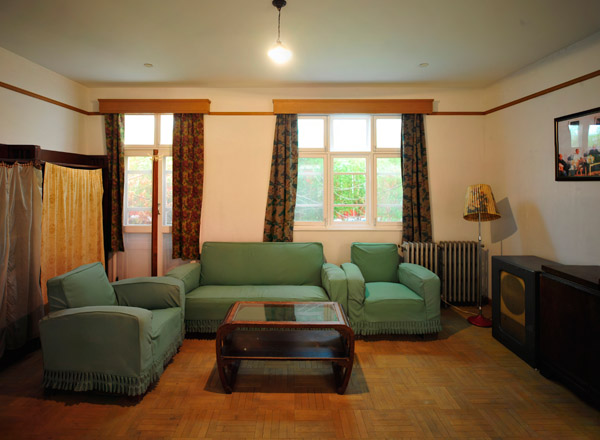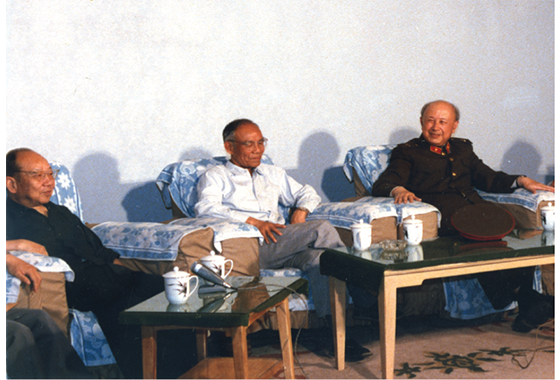Valuable Living Room Sofa
When the staff of the Qian Xuesen Library was to pay visit to the house of Qian Xuesen for the first time, they thought his home must be very splendid in style. However, when entering his apartment located in the aviation compound, they found all the houses were very common and simple. The wooden floor would shake and squeak if people walked on it, and the walls had become grey, with some parts peeling.
What surprised the staff is the simple life that the great scientist had been living.
The recovered scene of the living room in his home is on display in the No.3 exhibition hall, providing visitors a more clear and intuitive picture of his daily life.
The wooden tea table in the middle of the living room was allocated to him by the Fifth Institute of the Ministry of Defense. This wooden tea table had accompanied him from 1960 to 2003; its rims had been distressed. There is a five-storey bookshelf standing in the edge of the living room, which was allocated by the Chinese Academy of Science in 1956. This bookshelf was made of crisscrossed planks without glass, so Qian Xuesen used a piece of iron wire to hang a piece of cloth as bookshelf curtain to prevent dust. This bookshelf covered with a curtain had accompanied him for almost 40 years.
This set of combination sofas arranged around the tea table is very common in style, bulky, heavy and not to mention comfortable. It is supposed that few people would use stiff sofas like this nowadays. However, the value of this set of combination sofas lies in its history rather than its style. Many state leaders including former president Jiang Zemin, and former premier Wen Jiabao, as well as members of the Chinese Academy of Sciences and the Chinese Academy of Engineering, and many scientists and artists once sat on this set of combination sofas.
And the “four grand old men in aerospace” might be the persons who frequented Qian Xuesen most and the seated themselves on the sofas most often. The “four grand old men in aerospace” refers to Ren Xinmin, Tu Shoue, Huang Weilu and Liang Shounie, they were the founding members who worked together with Qian Xuesen to construct Chinese missiles, rockets, and aerospace technology. The restored scene of one side of the wall is on display, and we can see their photo with Qian Xuesen seated in the sofa.
In 1960, Sino-Soviet diplomatic relations worsened, with all Soviet experts withdrawn, which imposed huge trouble upon the missile simulation task of the Fifth Institute. Under the situation, Qian Xuesen invited the four chief designers to his house and together discussed critical technical issues in the living room sofa.
Adhering to democratic centralism, Qian Xuesen always let the four chief designers express their opinions. If they agreed with each other, then the issue was settled; if they disagreed with each other, and the issue was not pressing, they would continue to discuss it next week; if the issue was very urgent, Qian Xuesen would present his decision and assign it for the four chief designers to implement. When the issue was completed successfully, the whole team obtained the credit; if it failed, he would assume responsibility.
This method was very effective, for those chief designers could speak their hearts freely. Decades of years later, they still missed those days when they sat on the sofa and talked with each other on the weekends.
Qian Xuesen thought the principle of democratic centralism should also be followed in technical work. On July 16, 1996, Qian Xuesen wrote a letter to Liu Jiyuan, General Manager of the China Aerospace Corporation, and he summarized the most valuable experience in the development of Chinese Aerospace undertaking-namely, democratic centralism.
“I have published many articles about Chinese aerospace undertaking; when thinking of the past, what I think most important can be boiled down to one sentence: the scientific workers of the aerospace field carried out the democratic centralism under the lead of Premier Zhou and Marshal Nie Rongzhen.”
Besides the “grand four old men in aerospace” regularly visiting Qian Xuesen’ s home, many experts and scholars once seated themselves in this set of sofas, listened to Qian Xuesen’ s words, and exchanged their academic thoughts with each other. They came here with heartfelt delight, and left with fully loaded knowledge. This set of combination sofas was used for dozens of years, witnessed the starting and development process of Chinese missiles, rockets and aerospace undertakings, as well as numerous moments filled with the wisdom and wit of Qian Xuesen.


